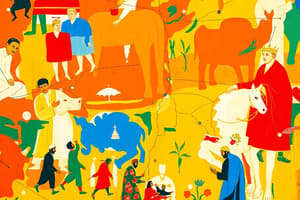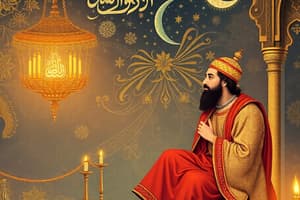Podcast
Questions and Answers
What is the correct definition of the term 'Arab'?
What is the correct definition of the term 'Arab'?
- A nomadic farmer from North Africa
- A person from any Middle Eastern country
- A descendant of the ancient Egyptians
- He who dwells in a tent (correct)
Which characteristic is NOT associated with the palace of Al Waleed bin Talal Al Saud?
Which characteristic is NOT associated with the palace of Al Waleed bin Talal Al Saud?
- It features 1,500 tons of Italian marble
- It has 317 rooms
- It is located in Riyadh, Saudi Arabia
- It is furnished with leather upholstery (correct)
What estimated net worth does Al Waleed bin Talal Al Saud hold?
What estimated net worth does Al Waleed bin Talal Al Saud hold?
- $50 billion
- $19.1 billion (correct)
- $25 billion
- $10 billion
What is significant about the dimensions of Al Waleed's palace?
What is significant about the dimensions of Al Waleed's palace?
Which of the following features is included in Al Waleed's palace?
Which of the following features is included in Al Waleed's palace?
How is Al Waleed bin Talal Al Saud notably regarded in the Middle East?
How is Al Waleed bin Talal Al Saud notably regarded in the Middle East?
What is meant by the statement related to the use of the term 'Arab'?
What is meant by the statement related to the use of the term 'Arab'?
Which of the following would NOT be an appropriate example of an 'Arab'?
Which of the following would NOT be an appropriate example of an 'Arab'?
What aspect best highlights the contrast between traditional Arab life and the lifestyle of Al Waleed bin Talal?
What aspect best highlights the contrast between traditional Arab life and the lifestyle of Al Waleed bin Talal?
What unique feature does the palace of Al Waleed bin Talal possess that emphasizes its opulence?
What unique feature does the palace of Al Waleed bin Talal possess that emphasizes its opulence?
What concept is highlighted by the term 'Arab' in the context provided?
What concept is highlighted by the term 'Arab' in the context provided?
What aspect distinguishes Al Waleed bin Talal Al Saud's lifestyle from traditional Arab life?
What aspect distinguishes Al Waleed bin Talal Al Saud's lifestyle from traditional Arab life?
Which statement accurately reflects Al Waleed bin Talal Al Saud's wealth?
Which statement accurately reflects Al Waleed bin Talal Al Saud's wealth?
How does the description of Al Waleed's palace challenge misconceptions about Arab identity?
How does the description of Al Waleed's palace challenge misconceptions about Arab identity?
What feature of Al Waleed's palace indicates its wealth?
What feature of Al Waleed's palace indicates its wealth?
What is the significance of describing Al Waleed bin Talal Al Saud's lifestyle with specific details?
What is the significance of describing Al Waleed bin Talal Al Saud's lifestyle with specific details?
What is the area of Al Waleed's palace, and how does it reflect his status?
What is the area of Al Waleed's palace, and how does it reflect his status?
Which of the following is least associated with the definition of 'Arab' provided?
Which of the following is least associated with the definition of 'Arab' provided?
What common misconception is illustrated by the mention of tents in relation to Arabs?
What common misconception is illustrated by the mention of tents in relation to Arabs?
What does the term 'Arab' exclude when applied to the Arabian Peninsula?
What does the term 'Arab' exclude when applied to the Arabian Peninsula?
Flashcards
Meaning of "Arab"
Meaning of "Arab"
"Arab" originally meant "one who dwells in a tent," but this definition doesn't apply to all people from the Arabian Peninsula.
Alwaleed bin Talal Al Saud
Alwaleed bin Talal Al Saud
The richest person in the Middle East, a Saudi Arabian prince with an estimated $19.1 billion net worth.
Kingdom Palace
Kingdom Palace
A 250,000-square-foot palace in Riyadh, Saudi Arabia, belonging to Alwaleed bin Talal, featuring luxurious amenities and materials.
Wealth of Alwaleed bin Talal
Wealth of Alwaleed bin Talal
Signup and view all the flashcards
Riyadh, Saudi Arabia
Riyadh, Saudi Arabia
Signup and view all the flashcards
Home of Alwaleed bin Talal
Home of Alwaleed bin Talal
Signup and view all the flashcards
Luxury Features
Luxury Features
Signup and view all the flashcards
5 Treasure Chests
5 Treasure Chests
Signup and view all the flashcards
Fief and illuminated manuscript
Fief and illuminated manuscript
Signup and view all the flashcards
Manhwa
Manhwa
Signup and view all the flashcards
What does "Arab" mean?
What does "Arab" mean?
Signup and view all the flashcards
Features of Kingdom Palace
Features of Kingdom Palace
Signup and view all the flashcards
Gothic Cathedrals
Gothic Cathedrals
Signup and view all the flashcards
Ribbed Vaults
Ribbed Vaults
Signup and view all the flashcards
Illuminated Manuscript
Illuminated Manuscript
Signup and view all the flashcards
Fief
Fief
Signup and view all the flashcards
Study Notes
Rise of Islam Notes
- Islam originated in the Arabian Peninsula in the early 600s.
- The peninsula was mostly desert, and many people were nomadic Bedouins, organized into clans for security.
- Permanent trade routes connected the Byzantine and Persian Empires via the Silk Roads.
- Mecca, a major trading and pilgrimage center, was along these routes.
- The Ka'aba was a place of worship with numerous idols.
- Monotheism, where one God is worshipped, also existed in the region (Arabic Christians and Jews).
- Muhammad, a descendant of Abraham, believed he was the last and greatest prophet in a series.
- Muhammad preached Islam in Mecca in 613 CE, but faced opposition and hostility.
- Many believed his teachings would damage Mecca's importance as a trading and pilgrimage center.
- In 622, Muhammad left Mecca for Yathrib (later renamed Medina) initiating the Hijra.
- In Medina, Muhammad united various groups into a community called the umma.
- In 630, Muhammad led 10,000 followers back to Mecca, and many converted to Islam.
- Muhammad died 2 years later (632 CE) at age 62.
- After his death, Muhammad's revelations were written in Arabic and collected into the Quran.
- The Quran became the holy book of Islam.
- Arabic was considered the true word of Allah, and was later used to unify conquered regions.
Key Islamic Principles
- Muslims do not worship idols.
- They worship one God, Allah.
- They must follow The Five Pillars of Islam.
- They do not eat pork or drink alcohol.
- There is no central religious authority figure.
Important Locations
- Mecca - Major trading and pilgrimage center.
- Medina - Where Muhammad established the umma (community).
- The Ka'aba - A central shrine in Mecca with numerous idols (prior to Islam).
- The Dome of the Rock - Oldest standing Islamic monument in Jerusalem.
Additional Notes
- The term "Arab" should not be used for all people of the Arabian Peninsula, as it has a more specific meaning.
- A man hid five treasure chests worth more than $2 million.
- There is a description of a large palace in Riyadh that cost millions of dollars.
Studying That Suits You
Use AI to generate personalized quizzes and flashcards to suit your learning preferences.



